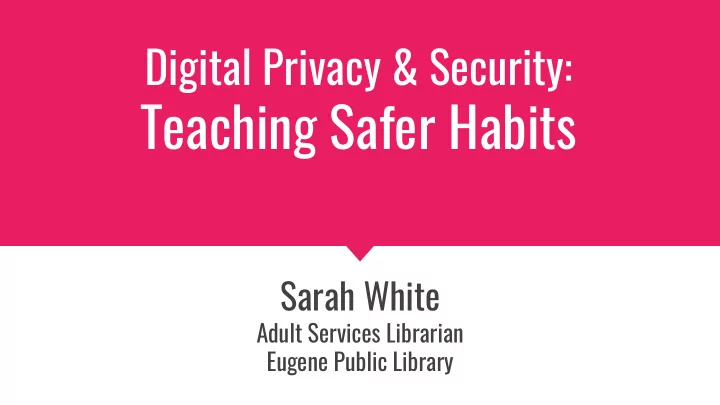

Digital Privacy & Security: Teaching Safer Habits Sarah White Adult Services Librarian Eugene Public Library
Goals for today ● Articulate why privacy is important to librarians/library stafg ● Understand threat modeling and the harm reduction approach to digital security ● Discover resources that will help transform you into a digital privacy advocate
Why privacy in libraries?
Activity: Speed friending Break into small groups and discuss the questions below: Privacy matters because... Where does patron privacy come up in your work? What is a digital privacy issue you wish you knew more about?
We protect each library user's right to privacy and confidentiality with respect to information sought or received and resources consulted, borrowed, acquired or transmitted. - American Library Association Code of Ethics
https://libraryfreedomproject.org/
13 librarians 6 months of online classes, 5 hours of work each week 1 in-person weekend
Topics include: ● General issues (e.g. CCTV) ● Library-specific issues (e.g. vendor privacy policies/practices) ● Technologies (e.g. Tor, Tails) ● General concepts (e.g. data minimization) Course materials at the Library Freedom Project's Wiki: https://libraryfreedom.wiki Surveillance Cameras by Quevaal
Speakers including: ● Nasma Ahmed, Digital Justice Lab ● Eric Hellman, Free Ebook Foundation ● Caroline Sinders ● Jessie Rossman, ACLU MA ● Freddy Martinez, Lucy Parsons Lab ● Eva Galperin, Electronic Frontier Foundation ● April Glaser, Slate Videos available at https://vimeo.com/libraryfreedominstitute
Key concepts
Principles of Harm Reduction (via the Electronic Frontier Foundation): 1. Everyone deserves digital security Harm reduction and privacy. 2. Remove the stigma of bad security or privacy practices. 3. Increasing digital safety is a process. 4. Harm reduction is collective. See https://sec.efg.org/articles/harm-reduction
A method for considering the potential risks to something you wish to Threat modeling protect, and the steps you’ll take to protect it. More info: https://ssd.eff.org/en/module/your-s ecurity-plan
Common questions to ask when creating a threat model What do you want to protect? These are your assets. Who do you want to protect it from? These are your adversaries . What information do you want to keep private? Who is likely to try to access it without your consent? What are the consequences if you fail? What are you willing to do to protect that information?
Example threat model assessment Jenny is leaving a difficult family situation and uses the library computers and wifi to access social media, look for housing, and read the news. She is worried that a particular family member will try to track her down and intimidate, bully, or physically harm her. From the Data Privacy Project’s Risk Assessment Page
Example threat model assessment The likelihood of this happening is high: for the past year, the family has depended on a family plan with their mobile phone provider. During that time, the whole family enabled phone tracking features. In addition, her family regularly shared passwords, making it possible for different members to post social media accounts in the account holder’s name.
Example threat model assessment What does she want to protect? Location information Who does she want to protect it from? A potentially abusive family member
Example threat model assessment What information does she want to keep private? Email messages Social media activity Who is likely to try to access it without her consent? A potentially abusive family member What are the consequences she fails? Intimidation, bullying, or physical harm
Example threat model assessment What is she willing to do to protect that information? ● Set up new cell phone account ● Create new, strong passwords Set up 2-factor authentication ● Remove location information from posted photos ● ● Use a device lock ● Make social media settings private
Activity: Threat Modeling Assessment Work in a small group. Think of a patron you know or have worked with in the past that fit one of these descriptions: ● An undocumented immigrant ● A teenager in a difficult family situation ● A senior with low digital literacy How do you think that patron would answer the threat modeling questions?
Adapting Lessons for your Library’s Patrons Tulane Public Relations [CC BY 2.0 (https://creativecommons.org/licenses/by/2.0)]
Before workshop topics are chosen, do some background reading and research.
Well before the workshop is scheduled, try out some of the tools for your own use. Read reviews of the ones you use.
Choose your topics. Locate lesson plans related to those topics. Adapt!
During the lesson: Start out with threat modeling and harm reduction, but don’t call it that! Be a cheerleader! Don’t be afraid to not know the answer. By Quinn Dombrowski from Berkeley, USA - The all-male cheerleader team, CC BY-SA 2.0, https://commons.wikimedia.org/w/index.php?curid=22895870
Example Activity
Create a Super Secure Passphrase: The Book Method 1. Close your eyes 2. Open your book to a random page 3. Put your finger somewhere on the page 4. Open your eyes and write down the word closest to your finger. 5. If the word is a very common (easy to guess) word, go back to step 1. Repeat steps 1-5 four more times, giving you a total of five words. Voila! You have a new passphrase. From the Security Education Companion intermediate lesson on passwords.
Thank you!
Recommend
More recommend